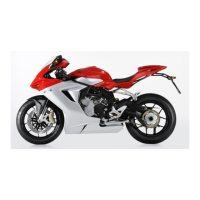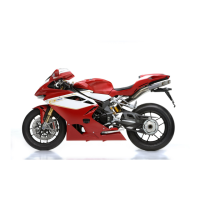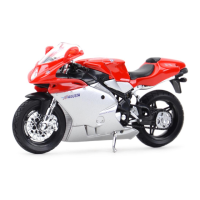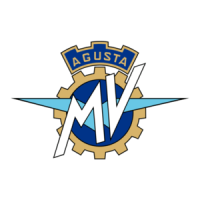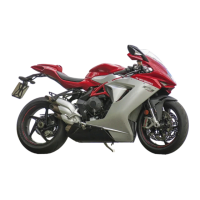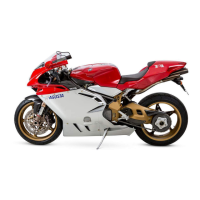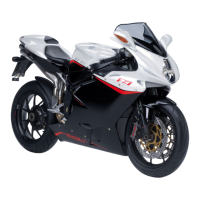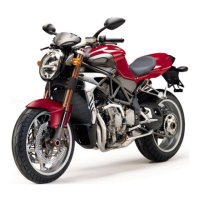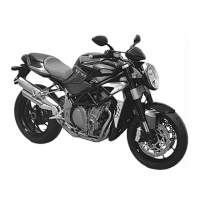Do you have a question about the MV Agusta F4 and is the answer not in the manual?
Explains the manual's objective and scope.
Explains important symbols used in the manual for safety and operations.
Details the warranty booklet and the process for service coupons.
Provides frame and engine serial numbers, and homologation data.
Advises on checking and maintaining magnesium components.
Guide on reporting vehicle defects that pose a safety risk.
Outlines the warranty for the exhaust system's noise emission compliance.
Prohibits tampering with noise control systems and outlines federal laws.
Explains the vehicle's emission control systems and their function.
Key safety precautions to follow before and during riding.
Provides advice on riding techniques, awareness, and adverse conditions.
Recommends essential protective clothing for rider safety.
Locates important safety warning labels on the motorcycle.
Emphasizes verifying the operation of lights, horn, and indicators before riding.
Identifies the location of all controls and instruments on the motorcycle.
Explains the function and safety switch of the sidestand.
Describes the function of controls on the left handlebar.
Describes the function of controls on the right handlebar.
Explains the ignition switch positions and steering lock function.
Details how to operate the gear lever and identify neutral.
Introduces the dashboard instruments and warning lights.
Explains the meaning and action for each warning light on the dashboard.
Details the speedometer, odometer, and thermometer functions.
Lists basic information for operating the motorcycle correctly.
Guides the initial period of operation for engine and other parts.
Provides step-by-step instructions for starting the engine (cold/hot).
Explains how to set clock, speedometer, and thermometer units.
Describes how to cycle through and select display functions.
Instructions on safely refuelling the motorcycle with correct fuel.
Instructions on how to access the glove compartment.
Safe procedures for parking the motorcycle using the sidestand or rear stand.
Lists essential checks to perform before each ride for safety.
Emphasizes the need for experience, training, and safety precautions while riding.
Introduces adjustments that improve ergonomics, geometry, and safety.
Provides a detailed overview of various adjustable components and their functions.
Instructions for adjusting the front brake lever position.
Instructions for adjusting the clutch lever position.
Guides on adjusting the position of rearview mirrors.
Explains how to adjust the steering damper for desired stiffness.
Details adjustments for front suspension spring preload and damping.
Details adjustments for rear suspension spring preload and damping.
Presents periodic maintenance schedules and checks for safety and performance.
Lists the tools and accessories included with the motorcycle.
Specifies recommended lubricants and fluids for the motorcycle.
Step-by-step guide to removing and refitting the right-hand side fairing.
Procedures for checking and topping up engine oil level.
Procedures for checking and topping up coolant level.
Checks for brake pad wear and brake fluid level.
How to check tyres, and adjust/lubricate the drive chain.
How to check the engine's idle speed.
Outlines periodic emission control operations and intervals.
Details warranty rights, responsibilities, and coverage for emission systems.
General guidance on replacing fuses and light bulbs.
Diagnosing issues when the engine won't start or is difficult to start.
Diagnosing and resolving engine overheating and low oil pressure.
Troubleshooting for lights, horn, speedometer, and charging system.
Labeled diagrams of the motorcycle and its main systems.
Diagrams and explanations of brake, clutch, and fuel systems.
Diagrams of engine lubrication and coolant circuits.
Detailed technical specifications and materials used in the motorcycle.
| Seat Height | 830 mm (32.7 in) |
|---|---|
| Displacement | 998 cc |
| Transmission | 6-speed |
| Frame | Tubular steel trellis |
| Rear Suspension | Progressive, single shock absorber with rebound and compression (High speed / Low speed) damping and spring preload adjustment |
| Front Brakes | Dual 320mm discs, Brembo 4-piston calipers |
| Rear Brakes | Single 210mm disc, Brembo 2-piston caliper |
| Dry Weight | 192 kg (423 lb) |
| Fuel Capacity | 17 L |
